How we ensured communication at the summits of the SCO and BRICS
Ufa is one of the largest economic, industrial and scientific centers of our country, with an extensive historical, cultural and sports heritage. In July 2015, international summits of the SCO and BRICS were held in Ufa.
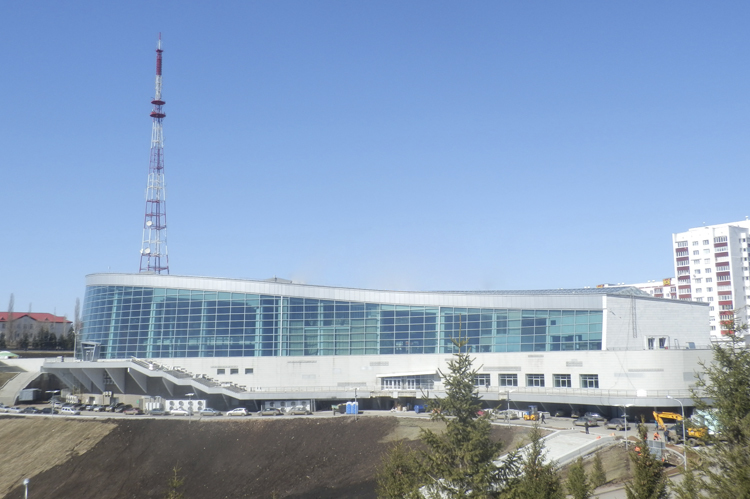
Congress Hall of the meetings of the international delegations of the SCO and BRICS in Ufa
At the event, it was necessary to ensure uninterrupted mobile communication of 4G, 3G, 2G technologies. Using the accumulated experience and applying various technical solutions, we had to expand the coverage of mobile communication at all new sites of the summits. I was responsible for the organizational and technical parts of this intensive project.
')
Ufa is the capital of the Republic of Bashkortostan, one of the key regions of the Volga region, located on the border of Europe and Asia. This multifaceted and multinational city organically absorbed all the traditions of the West, the East and the era of the Soviet period of our history, combining into a single whole all these different directions. It can be said that Ufa historically and geographically was intended to host West-Eastern events, such as international summits of the heads of states and governments of the SCO (China, Russia, Kazakhstan, Tajikistan, Kyrgyzstan, Uzbekistan, as well as India and Pakistan) and BRICS ( Brazil, Russia, India, China, and South Africa).
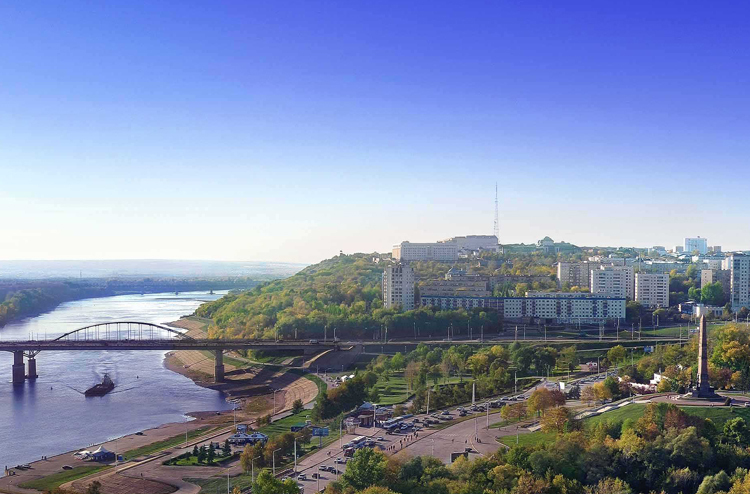
Panoramic view of Ufa
The events of the SCO and BRICS in Ufa were attended by about 10 thousand guests, both from countries participating in summits and from regions of our country. In addition to participants of the summits, as well as heads of international organizations, outside observers and official guests, on key days in the city were numerous representatives of special structures for the protection of delegations, support staff, over a thousand accredited journalists, volunteers, volunteers, and tourists on the occasion of various cultural events.
One of the industries involved in preparing Ufa for summits was the communications industry. At the event in Ufa, uninterrupted coverage of 4G / 3G / 2G mobile technologies was to be provided at all key sites for the summits. At the same time, both a stable voice service and a confident high-speed Internet access had to be provided. The task of preparing the city’s mobile network for the SCO and BRICS summits in our company received the status of a special project.

Map of the objects of the SCO and BRICS summits
The centralized preparation of Ufa for the event was headed by the Organizing Committee and was carried out along the lines of all involved sectoral departments (to be more precise, there were even two Organizing Committees: federal and republican). At the same time, due to security issues, we received little information to carry out targeted planning to cover our mobile network. Preliminary data on the routes of movement of foreign delegations in the city did not apply, there were only the end points of the stay. Therefore, we immediately decided to prepare for the event in Ufa sustainable coverage of 4G / 3G / 2G networks in the entire millionth city.
Having met with colleagues in the working group and having started the project from two directions at once, both in Ufa and in Moscow, we tried to synchronize all approaches to planning, construction and optimization of the mobile network. We broke into areas of responsibility and analyzed all possible options for preparing the Ufa network, both by the methods of “quick response from what we have” and by the methods of “long-term development of the network for the future”. In the end, both methods were used.

Entrance to Ufa through the southern "gates" of the city
To create a picture of our current 4G / 3G / 2G coverage at the sites of the SCO and BRICS summits, we went to the field with measuring equipment to collect information about the mobile network with the "eyes" of the subscriber. At first, it was necessary to “live” measure up the existing and under construction objects of the summits, to which our coverage was to undergo. Unfortunately, since some of the facilities were not yet ready and were being built up until the last month of key events, and this was especially true of new European hotels, to draw a picture of our 4G / 3G / 2G coverage, we had to rely on empirical knowledge for similar buildings according to typical radio propagation patterns. Very often, signalers to “enter” new sites and are almost always the last, almost at the same time as builders who carry out finishing work. Therefore, there is very little time left to optimize and tune systems. The advantage of mobile communication in such tasks is that it is wireless, so for long-term facilities there are backup options for deploying coverage from adjacent roofs of buildings.

Greeting guests of the city on the square to them. S. Yulaeva
An important independent task in the special project was to provide communication at Ufa airport. This object was supposed to be the first to meet foreign guests and, essentially, for the duration of the events of the SCO and BRICS, to become a “visiting card” not only of this region, but of the whole country as a whole. Ufa Airport is consistently among the ten largest airports, there is a steady increase in passenger traffic. A new terminal of international airlines was built for the summits here, and a second runway was upgraded, inherited from the Buran flight reservation program.
About how in major key airports in the country is designed and built mobile communications, previously described in a separate publication . In this article I would like to dwell on the implementation of the experience gained. In Ufa, it was at the airport that we almost missed the radio coverage planning, starting from the street methods of providing mobile communications. And it was from this object that we subsequently began to plan the entire special project as a whole more carefully.

Construction of a new international terminal at the airport
The fact is that at the Ufa airport we already had a stable external 4G / 3G / 2G coverage for the domestic airline terminal, and that was enough. At first, it was assumed that by increasing the capacity of street base stations, the existing coverage would be enough for the new terminal of international airlines. It was embarrassing that there were many metal structures in this terminal. Everything changed when the builders sheathed the terminal with modern panels, giving the building a finished look. The measurements of 4G / 3G / 2G inside the terminal under construction have shown that we cannot do without deploying a separate internal coating. An external street signal to “pierce” from a distant point a new airport terminal turned out to be extremely difficult. We began to change the layout for this airport position to the internal one on the move, “transferring” the position with 4G / 3G / 2G base stations to the building and reworking all our construction drawings with contractors during construction.
To deploy the internal coverage in the international terminal, we chose a passive distributed antenna system. Since all three cellular operators appeared before launching the terminal under the same conditions, after a joint meeting at the facility, they decided to design the internal antenna system for three. So, in a special project only on this one object, the complexity of the problem being solved simultaneously increased, and to create a uniform coverage, we had to quickly plan a lot of low-power antennas and evenly “hang” them on all floors of the building in the arrival and departure zones.
Further, during the preparation of the network, we analyzed all possible options, how to get our coverage to the city sites of the summits. I must say that the Organizing Committee made a fairly successful move in choosing the venue for summits in Ufa, since all the key events of the SCO and BRICS took place in the center of a million city in its southern part, and not outside the city in any designated area. Within walking distance were located the main centers of business activity of Ufa and historical sights. And in this part of the city we also had our own telecom infrastructure. We had to finish building additional base stations here and organically enter them into our existing mobile network.
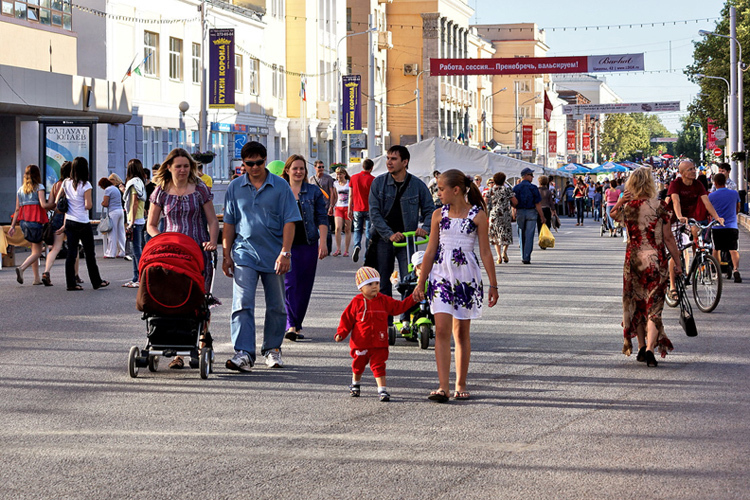
Ufa Arbat on Lenin Street
The approach to planning and enhancing 4G / 3G / 2G coverage was chosen in a special project not for a one-time action of the SCO and BRICS summits, but with an eye to the long-term development of the Ufa network. We were preparing to meet not only high-level delegations, but also planned to increase coverage for all residents of the city. All our subscribers were important for us: home and roaming, regardless of who came from. Sustainable mobile communication was required by everyone here, including for coordinating volunteers who came from all regions of the country and provided assistance to the city in working with delegations. The network, set up and enhanced by modern technologies, should have remained for residents of the city after international events, as there is a steady increase in both voice traffic and data traffic in Ufa. This is a dynamically developing million-plus city of the Volga region, and the prospects for using mobile communications here are very good.
As it turned out later, the Organizing Committee found the same approach to the event. In the days of the summits in Ufa, city events were planned, which were held for residents and guests of the city in the squares in front of the Russian Drama Theater, in the parks of Sipaylovo, Dema, Zaton and Chernikovka. Also in those days all the museums and galleries opened their doors, and each theater announced that it would present a series of its best performances.
The main sites of the SCO and BRICS summits were located in Ufa on a rather compact territory along Z. Validi Street. Objects such as the Ufa congress hall, an international press center for journalists, the television center of Bashkortostan, the Amphitheater for the Vatan national cultural exhibition exhibition, the city square with a monument to S. Yulaev with a viewing platform, and hotel with a panoramic view of the river Belaya. We planned to “illuminate” this territory from various sides, from where we could “finish off” sectors of our distant base stations. We also additionally found new points and designed the construction of street stations under the expected growth in data traffic.

Amphitheater with tents of the exhibition exhibition "Vatan"
This approach to strengthening coverage in this part of the city was associated not so much with the most important object of the summits - the congress hall for the meeting of delegations (where we planned to deploy a separate mobile communication system and more on that later), but rather with an international press center, located in the neighborhood , as well as with the exhibition Amphitheater of national cultures. The main requirement of the organizers was the provision of reliable voice calls and uninterrupted mobile Internet service in this compact territory. Obviously, overloading of 4G / 3G / 2G mobile networks and even less contingent situations during the days of the SCO and BRICS summits were unacceptable here.
The key object of the summits of the SCO and BRICS, as noted, was the Ufa congress hall, where multilateral delegations met. By the summits, the congress hall was substantially modernized, a lot of redevelopments were carried out in the building, and the underground parking was rebuilt into a full floor. The remaining floors of the building were redeveloped and divided into zones for negotiation of various levels. According to my own feelings from visiting the congress hall at the stage of reconstruction, in the Oval Hall of which the on-site meetings of all involved Ufa and Moscow telecommuters were held, it can be said that the design of the key object turned out to be quite modern and thoughtful inside. From the street, its architecture also looked solid and smart, well fitting into the embankment hilly landscape of Ufa.
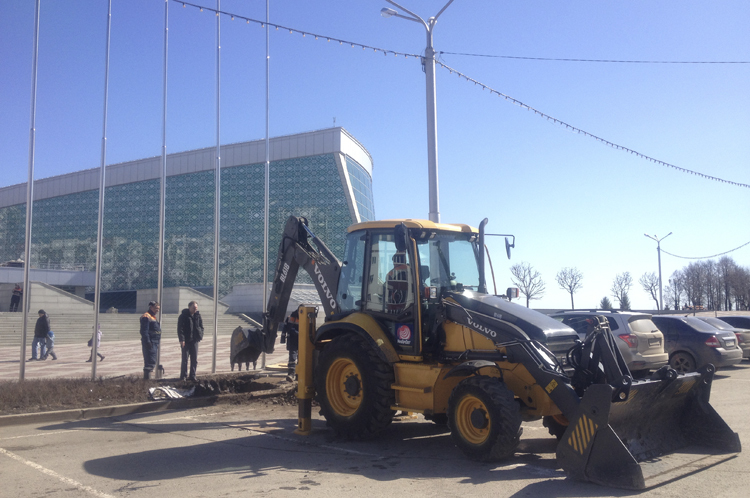
Preparation of flag stocks for participating countries in front of the congress hall
Architecturally, the building consisted of a large number of metal structures, various soundproof walls, ceilings, and metallized glass panes. The street signal here was difficult to break through. Therefore, like at the airport, we have designed in the congress hall, together with other cellular operators, a separate internal coverage based on a passive distributed antenna system and additional 4G / 3G / 2G base stations. For a confident distribution of the base station signal inside, antennas on all floors of the building were planned and installed to the maximum. After the summits, the building was supposed to be redesigned as a concert hall, which means that the work of cellular operators was to remain in demand.
Close to the congress hall of Ufa on the square to them. S. Yulaev organizers built a large international press center for journalists and television. It consisted of several functional areas - these were media offices, a briefing hall, and the Ufa pavilion, where journalists took official information about summits, the city and the Republic of Bashkortostan for use in their materials. The press center, fortunately, consisted of easily assembled awning structures, which are completely radio transparent to our base station signals. Due to the temporary nature of the facility, we did not plan for it and did not build any separate coverage. Our expanded street coverage of the mobile network should have been enough in this part of the city in full. There were only minor doubts that the projected capacity of street stations might not be enough in part, as more than one thousand two hundred journalists accredited to the summits, who could use our mobile services in a wide variety of applications.
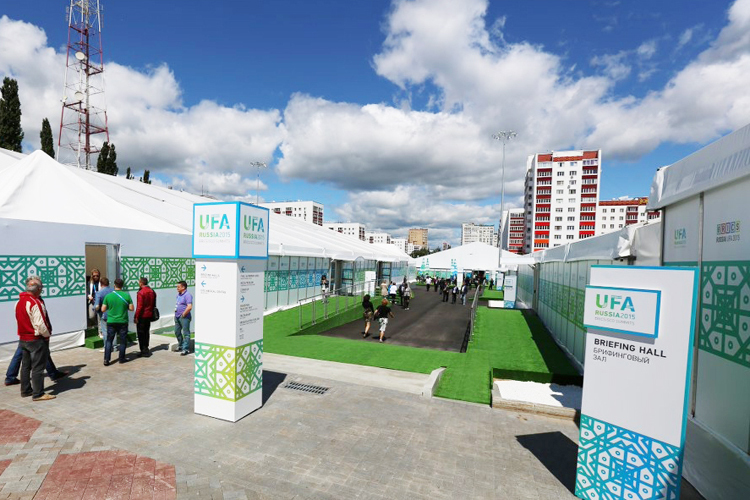
International Press Center Summits
The Opera and Ballet Theater of Ufa had a special role at the summits of the SCO and BRICS (where, by the way, a major overhaul was made, and the volume of work performed was somewhat similar to the reconstruction of the Bolshoi Theater in Moscow). In the days of the international event, above all, there were high-level receptions and one-on-one bilateral meetings. In the evening, for the participants of the SCO and BRICS summits, various cultural programs were held in the theater. For this object, we already had a stable street coverage of 4G / 3G / 2G networks. Base stations with antennas of all bands were installed on the roof of this building earlier. But to enhance coverage on the 0m and 1m floors of the theater, femto points of 3G were additionally planned and installed.

Opera and Ballet Theater with cellular antennas symmetrically located on the roof in white radio transparent caps
Also important key objects involved in Ufa for the reception of guests were the Bashkortostan State Concert Hall and the Art Museum named after them. Mv Nesterov. Additional facilities that required sustainable coverage were the shopping and entertainment complex Gostiny Dvor and the railway station. And at the listed facilities, we also carried out work on setting up the existing network coverage to provide a reliable mobile service.
In addition to the listed facilities, official receptions also required the provision of mobile communications in newly built hotels. Since the summit of the summits was a well-developed area of Ufa, we chose street coverage methods to “light up” the steady signal of new hotels and access roads to them. It was not a trivial task, as many modern hotel buildings are being built on individual projects using a large amount of reinforced concrete, which directly affects the penetration of the street signal.
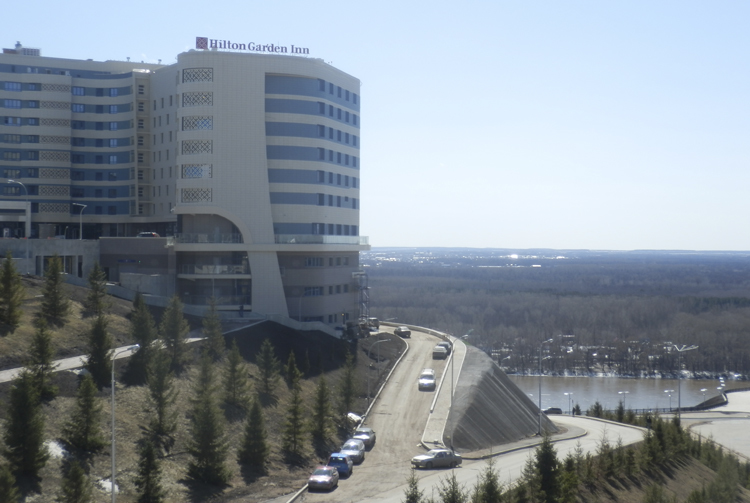
Hotel complex on the embankment of the Belaya River
A separate issue in the project was negotiating the cost of renting positions on the roofs of buildings to house our antennas and base stations. It was not easy for us to solve the problem of renting technological sites in the conditions of upcoming events, because everyone prepared for summits in the city in his own way. In connection with the ongoing activities, some landlords were ready not to miss their chance and could agree to rent positions only at “normal” prices. Therefore, in the special project, the negotiation process with landlords during the preparatory actions had to be conducted very carefully.
The organizers also asked us to pay attention to two suburban boarding houses and also to provide them with a stable mobile connection, which we did. In one of them the flight crews of special detachments of representatives of foreign states were stationed. In the other - additional attendants who arrived in the city to accompany officials. Since the boarding houses were only seasonal, we planned to “drive” 3G mobile base stations to Ufa from neighboring regions to help cover the existing 2G suburban coverage to cover these sites with 3G mobile Internet.

Mobile base stations providing communication in suburban boarding houses
As mobile base stations, we did not use Gazelles with Kamaz, as can sometimes be seen at such events, but special trailed vans. Such technical solutions are more budget and, at the same time, easy to transport using standard machines. Although practice has shown that these base stations need to be transported carefully enough due to the maximum load by vehicle weight. Energy for mobile stations was subsequently used not diesel, but fortunately the usual stationary from boarding houses.
Speaking about the subsequent configuration of our mobile network in Ufa, it is worth mentioning in general about the recent subscriber preferences. Now they are such that in large cities the number of built base stations no longer solves the problem of mobile network perception. The question of the availability of 4G / 3G / 2G coverage, which was once perceived as “happiness,” has now been transformed into a subjective factor in the sensations of using services. The rhetorical question is how to lay in the mobile network the coefficient of "happiness" of a subscriber who is actively moving over a large territory during a day, staying now in buildings, now on the street, now in moving vehicles, and trying to use all the services at the same time?
There is no universal answer here. But there is a constant work on tuning and optimizing the load of base stations, taking into account the technical experience of the company's employees. Despite the fact that after the completion of the construction of each new base station, the mobile network, as a rule, expands the coverage of the territory of the city and passes more subscriber traffic, the monitoring of the capacity of the stations should be performed continuously. And working on the special project of preparing Ufa for the SCO and BRICS event, we devoted a lot of time to searching for settings for the optimal functioning of the mobile network. Essentially, the settings optimization stage has become a real field for creativity. In connection with the preparation for the summits, we tried to look at the city’s mobile network with a “non-salient” look and re-think everything that we could do for subscribers to the event.

Base station, combined with a bus stop and a billboard, built on the road from the airport
The only limitation in the project was for us that the mobile network of this million city should not become a testing ground for "raw" technical solutions. Risks at the event of the SCO and BRICS were not allowed. Required the stability of the mobile network in terms of the projected growth in subscriber load, above all this. And as a result, a lot of tuning work was done in Ufa: these are system-wide changes and work with individual sectors of base stations. Most of the work concerned the expansion of the capacity of 4G / 3G / 2G networks and were, in general, standard. But there were also such works, about the logic of application of which I would like to tell more.
For the 2G network of Ufa, which is mostly “sharpened” for voice traffic, we checked and, if necessary, preconfigured at base stations the lists of sectors of “neighboring” stations. , , . «» , . - , - , .., . .
2G , . , 2G , , , . «» 2G . iPhone' – , «», .
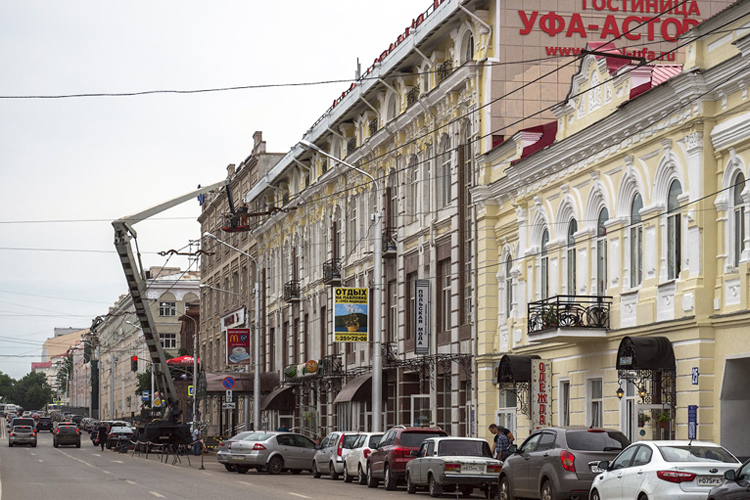
2G «» . 2G . , 2G , , . 2G . 2G , , , .
2G , . - 2G . 2G. : 2G «» . 2G «» . . , , . 2G.
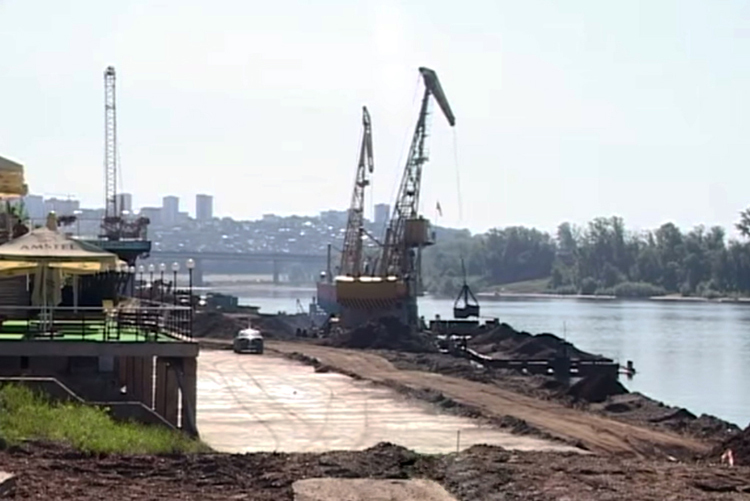
2G . , 3G 4G , 2G - «» . , 2G . - , , - , «» 3G 4G, «» 2G . 2G.
3G «» , , , . 4G , - 3G . 3G . 3G . , 3G , , «» 4G 3G, .
, 3G . . , 3G . , 3G , 3G 2 . - . , . 99% 3G, , .
3G , . , , 3 , «» . , 3G , , - .

,
3G download « » ( ), upload « ». , , . « » 3G . 3G , 3G. : - , ping .
3G , , , . «» , . 3G , , , 3G . -, , . , -, «» . «» 3G , .
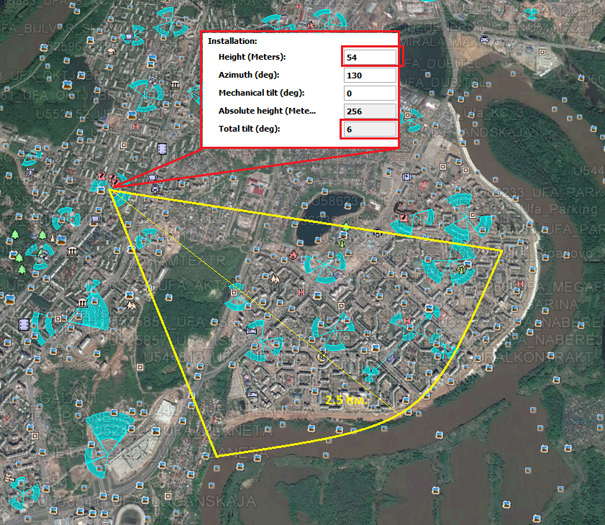
«» 3G
, 3G , , . 3G . 3G , , – . : , , , 2G, 3G, 2G 3G. 3G 2G, 3G, 4G.
4G, 3G 2G – , - 3G 2G, . 4G , , , , . : – 4G, – , – .
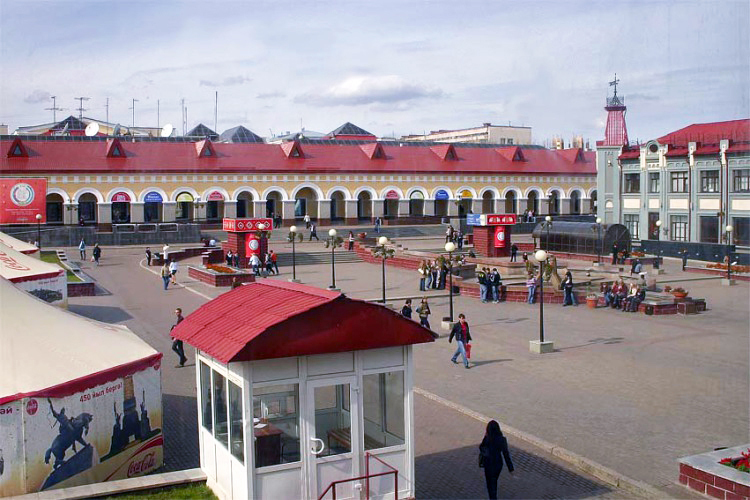
- ,
4G . , « ». . , «», , . . 4G 2600 , 4G.
4G , «» 4G 3G . 4G, «» 3G , 4G . 4G -. 4G .
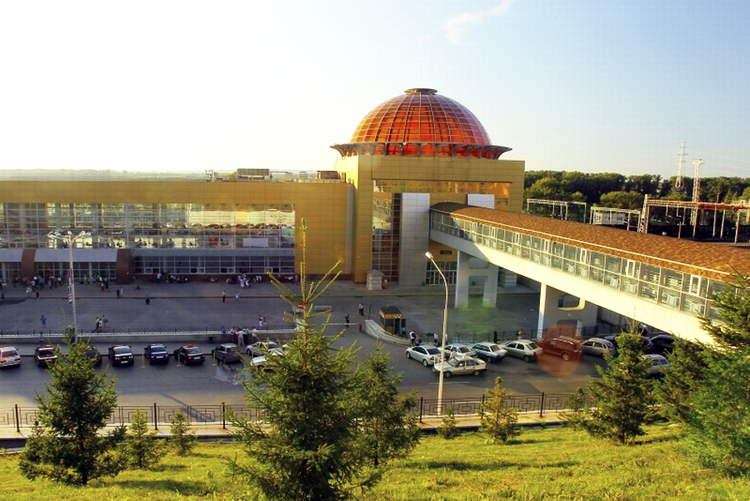
,
, 4G . 4G , . LTE 4G . 3G 2G. 4G Voice over LTE . 4G – . Voice over LTE. , 4G : 4G 3G 2G , . 4G–3G/2G–4G .
, 4G . 4G . , : , . And this is good. 4G .
4G/3G/2G, , « » . , , , . , , . , , , , .
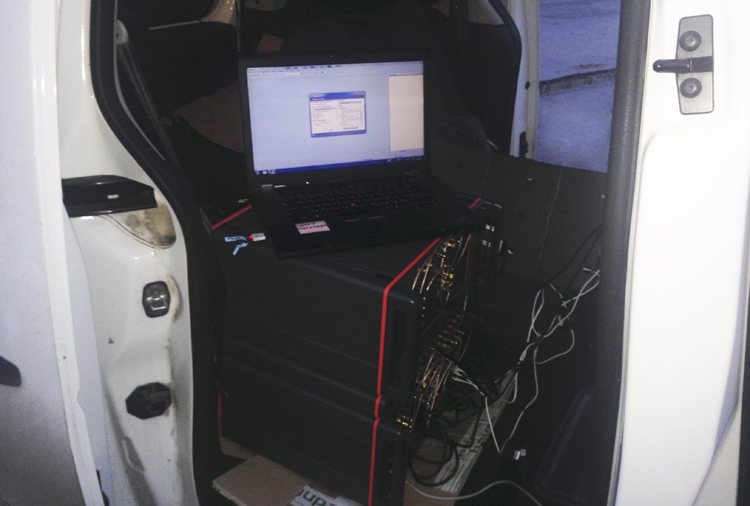
4G/3G/2G,
, «» 4G/3G/2G. , , . «» .
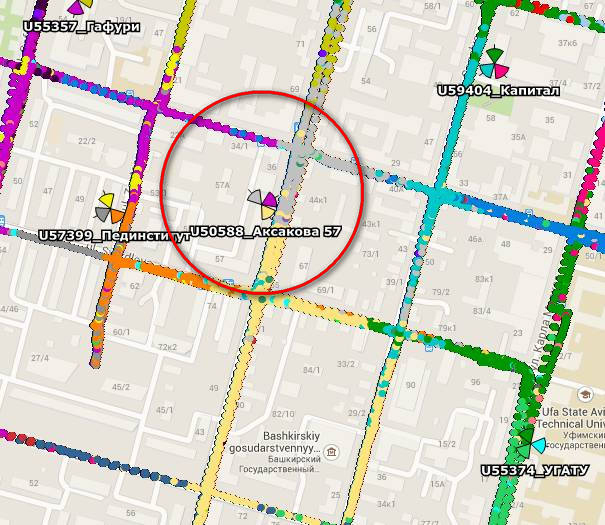
«» 3G : , –
4G/3G/2G . 4G 16,67 /. 3G 7,15 /. 3G 2G 0,54 %, 2,91 %. - 5 /. -, . 5%, .
4G/3G/2G. . , , , , . . - .
, . , . 4G/3G/2G , .

. , , . . , «» . , , , , .
: - «» , , «» , , -. .
, , , . , .
4G/3G/2G , , , «» . . , , .
, : . , , . . .

Congress Hall of the meetings of the international delegations of the SCO and BRICS in Ufa
At the event, it was necessary to ensure uninterrupted mobile communication of 4G, 3G, 2G technologies. Using the accumulated experience and applying various technical solutions, we had to expand the coverage of mobile communication at all new sites of the summits. I was responsible for the organizational and technical parts of this intensive project.
')
Organizational matters
Ufa is the capital of the Republic of Bashkortostan, one of the key regions of the Volga region, located on the border of Europe and Asia. This multifaceted and multinational city organically absorbed all the traditions of the West, the East and the era of the Soviet period of our history, combining into a single whole all these different directions. It can be said that Ufa historically and geographically was intended to host West-Eastern events, such as international summits of the heads of states and governments of the SCO (China, Russia, Kazakhstan, Tajikistan, Kyrgyzstan, Uzbekistan, as well as India and Pakistan) and BRICS ( Brazil, Russia, India, China, and South Africa).

Panoramic view of Ufa
The events of the SCO and BRICS in Ufa were attended by about 10 thousand guests, both from countries participating in summits and from regions of our country. In addition to participants of the summits, as well as heads of international organizations, outside observers and official guests, on key days in the city were numerous representatives of special structures for the protection of delegations, support staff, over a thousand accredited journalists, volunteers, volunteers, and tourists on the occasion of various cultural events.
One of the industries involved in preparing Ufa for summits was the communications industry. At the event in Ufa, uninterrupted coverage of 4G / 3G / 2G mobile technologies was to be provided at all key sites for the summits. At the same time, both a stable voice service and a confident high-speed Internet access had to be provided. The task of preparing the city’s mobile network for the SCO and BRICS summits in our company received the status of a special project.

Map of the objects of the SCO and BRICS summits
The centralized preparation of Ufa for the event was headed by the Organizing Committee and was carried out along the lines of all involved sectoral departments (to be more precise, there were even two Organizing Committees: federal and republican). At the same time, due to security issues, we received little information to carry out targeted planning to cover our mobile network. Preliminary data on the routes of movement of foreign delegations in the city did not apply, there were only the end points of the stay. Therefore, we immediately decided to prepare for the event in Ufa sustainable coverage of 4G / 3G / 2G networks in the entire millionth city.
Task performance
Having met with colleagues in the working group and having started the project from two directions at once, both in Ufa and in Moscow, we tried to synchronize all approaches to planning, construction and optimization of the mobile network. We broke into areas of responsibility and analyzed all possible options for preparing the Ufa network, both by the methods of “quick response from what we have” and by the methods of “long-term development of the network for the future”. In the end, both methods were used.

Entrance to Ufa through the southern "gates" of the city
To create a picture of our current 4G / 3G / 2G coverage at the sites of the SCO and BRICS summits, we went to the field with measuring equipment to collect information about the mobile network with the "eyes" of the subscriber. At first, it was necessary to “live” measure up the existing and under construction objects of the summits, to which our coverage was to undergo. Unfortunately, since some of the facilities were not yet ready and were being built up until the last month of key events, and this was especially true of new European hotels, to draw a picture of our 4G / 3G / 2G coverage, we had to rely on empirical knowledge for similar buildings according to typical radio propagation patterns. Very often, signalers to “enter” new sites and are almost always the last, almost at the same time as builders who carry out finishing work. Therefore, there is very little time left to optimize and tune systems. The advantage of mobile communication in such tasks is that it is wireless, so for long-term facilities there are backup options for deploying coverage from adjacent roofs of buildings.

Greeting guests of the city on the square to them. S. Yulaeva
An important independent task in the special project was to provide communication at Ufa airport. This object was supposed to be the first to meet foreign guests and, essentially, for the duration of the events of the SCO and BRICS, to become a “visiting card” not only of this region, but of the whole country as a whole. Ufa Airport is consistently among the ten largest airports, there is a steady increase in passenger traffic. A new terminal of international airlines was built for the summits here, and a second runway was upgraded, inherited from the Buran flight reservation program.
About how in major key airports in the country is designed and built mobile communications, previously described in a separate publication . In this article I would like to dwell on the implementation of the experience gained. In Ufa, it was at the airport that we almost missed the radio coverage planning, starting from the street methods of providing mobile communications. And it was from this object that we subsequently began to plan the entire special project as a whole more carefully.

Construction of a new international terminal at the airport
The fact is that at the Ufa airport we already had a stable external 4G / 3G / 2G coverage for the domestic airline terminal, and that was enough. At first, it was assumed that by increasing the capacity of street base stations, the existing coverage would be enough for the new terminal of international airlines. It was embarrassing that there were many metal structures in this terminal. Everything changed when the builders sheathed the terminal with modern panels, giving the building a finished look. The measurements of 4G / 3G / 2G inside the terminal under construction have shown that we cannot do without deploying a separate internal coating. An external street signal to “pierce” from a distant point a new airport terminal turned out to be extremely difficult. We began to change the layout for this airport position to the internal one on the move, “transferring” the position with 4G / 3G / 2G base stations to the building and reworking all our construction drawings with contractors during construction.
To deploy the internal coverage in the international terminal, we chose a passive distributed antenna system. Since all three cellular operators appeared before launching the terminal under the same conditions, after a joint meeting at the facility, they decided to design the internal antenna system for three. So, in a special project only on this one object, the complexity of the problem being solved simultaneously increased, and to create a uniform coverage, we had to quickly plan a lot of low-power antennas and evenly “hang” them on all floors of the building in the arrival and departure zones.
Further, during the preparation of the network, we analyzed all possible options, how to get our coverage to the city sites of the summits. I must say that the Organizing Committee made a fairly successful move in choosing the venue for summits in Ufa, since all the key events of the SCO and BRICS took place in the center of a million city in its southern part, and not outside the city in any designated area. Within walking distance were located the main centers of business activity of Ufa and historical sights. And in this part of the city we also had our own telecom infrastructure. We had to finish building additional base stations here and organically enter them into our existing mobile network.

Ufa Arbat on Lenin Street
The approach to planning and enhancing 4G / 3G / 2G coverage was chosen in a special project not for a one-time action of the SCO and BRICS summits, but with an eye to the long-term development of the Ufa network. We were preparing to meet not only high-level delegations, but also planned to increase coverage for all residents of the city. All our subscribers were important for us: home and roaming, regardless of who came from. Sustainable mobile communication was required by everyone here, including for coordinating volunteers who came from all regions of the country and provided assistance to the city in working with delegations. The network, set up and enhanced by modern technologies, should have remained for residents of the city after international events, as there is a steady increase in both voice traffic and data traffic in Ufa. This is a dynamically developing million-plus city of the Volga region, and the prospects for using mobile communications here are very good.
As it turned out later, the Organizing Committee found the same approach to the event. In the days of the summits in Ufa, city events were planned, which were held for residents and guests of the city in the squares in front of the Russian Drama Theater, in the parks of Sipaylovo, Dema, Zaton and Chernikovka. Also in those days all the museums and galleries opened their doors, and each theater announced that it would present a series of its best performances.
The main sites of the SCO and BRICS summits were located in Ufa on a rather compact territory along Z. Validi Street. Objects such as the Ufa congress hall, an international press center for journalists, the television center of Bashkortostan, the Amphitheater for the Vatan national cultural exhibition exhibition, the city square with a monument to S. Yulaev with a viewing platform, and hotel with a panoramic view of the river Belaya. We planned to “illuminate” this territory from various sides, from where we could “finish off” sectors of our distant base stations. We also additionally found new points and designed the construction of street stations under the expected growth in data traffic.

Amphitheater with tents of the exhibition exhibition "Vatan"
This approach to strengthening coverage in this part of the city was associated not so much with the most important object of the summits - the congress hall for the meeting of delegations (where we planned to deploy a separate mobile communication system and more on that later), but rather with an international press center, located in the neighborhood , as well as with the exhibition Amphitheater of national cultures. The main requirement of the organizers was the provision of reliable voice calls and uninterrupted mobile Internet service in this compact territory. Obviously, overloading of 4G / 3G / 2G mobile networks and even less contingent situations during the days of the SCO and BRICS summits were unacceptable here.
The key object of the summits of the SCO and BRICS, as noted, was the Ufa congress hall, where multilateral delegations met. By the summits, the congress hall was substantially modernized, a lot of redevelopments were carried out in the building, and the underground parking was rebuilt into a full floor. The remaining floors of the building were redeveloped and divided into zones for negotiation of various levels. According to my own feelings from visiting the congress hall at the stage of reconstruction, in the Oval Hall of which the on-site meetings of all involved Ufa and Moscow telecommuters were held, it can be said that the design of the key object turned out to be quite modern and thoughtful inside. From the street, its architecture also looked solid and smart, well fitting into the embankment hilly landscape of Ufa.

Preparation of flag stocks for participating countries in front of the congress hall
Architecturally, the building consisted of a large number of metal structures, various soundproof walls, ceilings, and metallized glass panes. The street signal here was difficult to break through. Therefore, like at the airport, we have designed in the congress hall, together with other cellular operators, a separate internal coverage based on a passive distributed antenna system and additional 4G / 3G / 2G base stations. For a confident distribution of the base station signal inside, antennas on all floors of the building were planned and installed to the maximum. After the summits, the building was supposed to be redesigned as a concert hall, which means that the work of cellular operators was to remain in demand.
Close to the congress hall of Ufa on the square to them. S. Yulaev organizers built a large international press center for journalists and television. It consisted of several functional areas - these were media offices, a briefing hall, and the Ufa pavilion, where journalists took official information about summits, the city and the Republic of Bashkortostan for use in their materials. The press center, fortunately, consisted of easily assembled awning structures, which are completely radio transparent to our base station signals. Due to the temporary nature of the facility, we did not plan for it and did not build any separate coverage. Our expanded street coverage of the mobile network should have been enough in this part of the city in full. There were only minor doubts that the projected capacity of street stations might not be enough in part, as more than one thousand two hundred journalists accredited to the summits, who could use our mobile services in a wide variety of applications.

International Press Center Summits
The Opera and Ballet Theater of Ufa had a special role at the summits of the SCO and BRICS (where, by the way, a major overhaul was made, and the volume of work performed was somewhat similar to the reconstruction of the Bolshoi Theater in Moscow). In the days of the international event, above all, there were high-level receptions and one-on-one bilateral meetings. In the evening, for the participants of the SCO and BRICS summits, various cultural programs were held in the theater. For this object, we already had a stable street coverage of 4G / 3G / 2G networks. Base stations with antennas of all bands were installed on the roof of this building earlier. But to enhance coverage on the 0m and 1m floors of the theater, femto points of 3G were additionally planned and installed.

Opera and Ballet Theater with cellular antennas symmetrically located on the roof in white radio transparent caps
Also important key objects involved in Ufa for the reception of guests were the Bashkortostan State Concert Hall and the Art Museum named after them. Mv Nesterov. Additional facilities that required sustainable coverage were the shopping and entertainment complex Gostiny Dvor and the railway station. And at the listed facilities, we also carried out work on setting up the existing network coverage to provide a reliable mobile service.
In addition to the listed facilities, official receptions also required the provision of mobile communications in newly built hotels. Since the summit of the summits was a well-developed area of Ufa, we chose street coverage methods to “light up” the steady signal of new hotels and access roads to them. It was not a trivial task, as many modern hotel buildings are being built on individual projects using a large amount of reinforced concrete, which directly affects the penetration of the street signal.

Hotel complex on the embankment of the Belaya River
A separate issue in the project was negotiating the cost of renting positions on the roofs of buildings to house our antennas and base stations. It was not easy for us to solve the problem of renting technological sites in the conditions of upcoming events, because everyone prepared for summits in the city in his own way. In connection with the ongoing activities, some landlords were ready not to miss their chance and could agree to rent positions only at “normal” prices. Therefore, in the special project, the negotiation process with landlords during the preparatory actions had to be conducted very carefully.
The organizers also asked us to pay attention to two suburban boarding houses and also to provide them with a stable mobile connection, which we did. In one of them the flight crews of special detachments of representatives of foreign states were stationed. In the other - additional attendants who arrived in the city to accompany officials. Since the boarding houses were only seasonal, we planned to “drive” 3G mobile base stations to Ufa from neighboring regions to help cover the existing 2G suburban coverage to cover these sites with 3G mobile Internet.

Mobile base stations providing communication in suburban boarding houses
As mobile base stations, we did not use Gazelles with Kamaz, as can sometimes be seen at such events, but special trailed vans. Such technical solutions are more budget and, at the same time, easy to transport using standard machines. Although practice has shown that these base stations need to be transported carefully enough due to the maximum load by vehicle weight. Energy for mobile stations was subsequently used not diesel, but fortunately the usual stationary from boarding houses.
Setting up 4G / 3G / 2G networks
Speaking about the subsequent configuration of our mobile network in Ufa, it is worth mentioning in general about the recent subscriber preferences. Now they are such that in large cities the number of built base stations no longer solves the problem of mobile network perception. The question of the availability of 4G / 3G / 2G coverage, which was once perceived as “happiness,” has now been transformed into a subjective factor in the sensations of using services. The rhetorical question is how to lay in the mobile network the coefficient of "happiness" of a subscriber who is actively moving over a large territory during a day, staying now in buildings, now on the street, now in moving vehicles, and trying to use all the services at the same time?
There is no universal answer here. But there is a constant work on tuning and optimizing the load of base stations, taking into account the technical experience of the company's employees. Despite the fact that after the completion of the construction of each new base station, the mobile network, as a rule, expands the coverage of the territory of the city and passes more subscriber traffic, the monitoring of the capacity of the stations should be performed continuously. And working on the special project of preparing Ufa for the SCO and BRICS event, we devoted a lot of time to searching for settings for the optimal functioning of the mobile network. Essentially, the settings optimization stage has become a real field for creativity. In connection with the preparation for the summits, we tried to look at the city’s mobile network with a “non-salient” look and re-think everything that we could do for subscribers to the event.

Base station, combined with a bus stop and a billboard, built on the road from the airport
The only limitation in the project was for us that the mobile network of this million city should not become a testing ground for "raw" technical solutions. Risks at the event of the SCO and BRICS were not allowed. Required the stability of the mobile network in terms of the projected growth in subscriber load, above all this. And as a result, a lot of tuning work was done in Ufa: these are system-wide changes and work with individual sectors of base stations. Most of the work concerned the expansion of the capacity of 4G / 3G / 2G networks and were, in general, standard. But there were also such works, about the logic of application of which I would like to tell more.
1. Preparing 2G network
For the 2G network of Ufa, which is mostly “sharpened” for voice traffic, we checked and, if necessary, preconfigured at base stations the lists of sectors of “neighboring” stations. , , . «» , . - , - , .., . .
2G , . , 2G , , , . «» 2G . iPhone' – , «», .

2G «» . 2G . , 2G , , . 2G . 2G , , , .
2G , . - 2G . 2G. : 2G «» . 2G «» . . , , . 2G.

2G . , 3G 4G , 2G - «» . , 2G . - , , - , «» 3G 4G, «» 2G . 2G.
2. 3G
3G «» , , , . 4G , - 3G . 3G . 3G . , 3G , , «» 4G 3G, .
, 3G . . , 3G . , 3G , 3G 2 . - . , . 99% 3G, , .
3G , . , , 3 , «» . , 3G , , - .

,
3G download « » ( ), upload « ». , , . « » 3G . 3G , 3G. : - , ping .
3G , , , . «» , . 3G , , , 3G . -, , . , -, «» . «» 3G , .

«» 3G
, 3G , , . 3G . 3G , , – . : , , , 2G, 3G, 2G 3G. 3G 2G, 3G, 4G.
3. 4G
4G, 3G 2G – , - 3G 2G, . 4G , , , , . : – 4G, – , – .

- ,
4G . , « ». . , «», , . . 4G 2600 , 4G.
4G , «» 4G 3G . 4G, «» 3G , 4G . 4G -. 4G .

,
, 4G . 4G , . LTE 4G . 3G 2G. 4G Voice over LTE . 4G – . Voice over LTE. , 4G : 4G 3G 2G , . 4G–3G/2G–4G .
, 4G . 4G . , : , . And this is good. 4G .
4. 4G/3G/2G
4G/3G/2G, , « » . , , , . , , . , , , , .

4G/3G/2G,
, «» 4G/3G/2G. , , . «» .

«» 3G : , –
4G/3G/2G . 4G 16,67 /. 3G 7,15 /. 3G 2G 0,54 %, 2,91 %. - 5 /. -, . 5%, .
results
4G/3G/2G. . , , , , . . - .
, . , . 4G/3G/2G , .

. , , . . , «» . , , , , .
: - «» , , «» , , -. .
, , , . , .
4G/3G/2G , , , «» . . , , .
, : . , , . . .
Source: https://habr.com/ru/post/262525/
All Articles